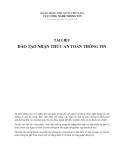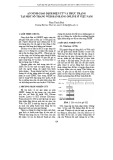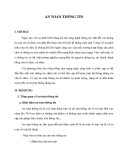
124
Số 11 (2023): 124 – 130
KHUNG BẢO MẬT ĐỂ ĐIỀU CHỈNH YÊU CẦU NGƯỜI DÙNG
CHO NHIỀU CẤP ĐỘ ỨNG DỤNG
Ngô Hải Anh1*, Lê Anh Tú2
1Viện Công nghệ thông tin, Viện Hàn lâm Khoa học và Công nghệ Việt Nam
2Phòng Đào tạo, Trường Đại học Hạ Long
* Email: ngohaianh@gmail.com
Ngày nhận bài: 13/11/2023
Ngày nhận bài sửa sau phản biện: 14/12/2023
Ngày chấp nhận đăng: 22/12/2023
TÓM TẮT
Các doanh nghiệp vừa và nhỏ (SME) có thể vận hành các dịch vụ mới nếu họ đáp ứng
các tiêu chuẩn đánh giá bảo mật trước khi xây dựng và triển khai dịch vụ mới. Các nhà cung
cấp dịch vụ, bao gồm cả các công ty SME, tiến hành đánh giá bảo mật của riêng họ trước khi
mở dịch vụ, nhưng thực tế có những hạn chế trong việc đáp ứng các yêu cầu chi tiết của từng
bộ phận trong tổ chức và các thay đổi môi trường khác nhau đối với tài sản của công ty như đám
mây. Hầu hết các nghiên cứu hiện tại tập trung cải thiện các mục trong danh sách kiểm tra đánh
giá bảo mật và xác minh tính hiệu quả, mà có ít nghiên cứu phân tích và tổng hợp các kết quả
trường hợp thực tế. Vì vậy, bài viết này phân tích kết quả rà soát bảo mật cho toàn bộ quá trình
từ lập kế hoạch đến vận hành hệ thống và dịch vụ đang vận hành, đồng thời đề xuất kế hoạch rà
soát, tiến hành phù hợp theo quan điểm của người thực hiện bảo mật.
Từ khóa: chính sách bảo mật, cấp độ bảo mật, đánh giá bảo mật, khung bảo mật
SECURITY FRAMEWORK FOR ADAPTING USER REQUIREMENTS
FOR MULTIPLE APPLICATION LEVELS
ABSTRACT
Small and medium-sized enterprises (SMEs) were able to operate new services if they
met the standards after receiving security reviews before building new services and
implementing services. Before launching services, service providers—including small and
medium-sized enterprises—conduct their own security reviews. However, due to various
environmental changes and practical constraints, it is not always possible to meet all of the
specific requirements of every department within the company, including the cloud. Existing
studies have been conducted to improve the items of the security review checklist and verify its
effectiveness, but there are insufficient studies to analyze and synthesize actual case results.
Therefore, this paper analyses the results of the security review for the entire process from
planning to operation of the system and service in operation and proposes an appropriate review
and proceeding plan from the security practitioner’s point of view.
Keywords: security policy, security framework, security levels, security review

Số 11 (2023): 124 – 130
125
KHOA HỌC TỰ NHIÊN
1. INTRODUCTION
Small and medium-sized enterprises
(SMEs) had to undergo security deliberations
from related agencies before establishing
new electronic financial services and
implementing related services. However, as
the number of subjects to be deliberated
increased due to the revitalization of the
fintech business, the security review was
changed to proceed with the company itself
and maintain the security level on its own.
Therefore, each company conducts its
security review for new services, and if it is
difficult to make its judgment, it contacts the
relevant institution (the FSS – Financial
Supervisory Service) for answers through a
“non-action statement”. However, changes in
the internal environment as technology
advances exist as a value that a company
must continuously address and supplement,
and there have been practical limitations in
meeting various security requirements from
the interests of each organization and from
the perspective. In this regard, existing
studies often changed or added checklists and
important items to improve security review,
and the effectiveness was reviewed, and the
analysis and review of actual service cases
were insufficient.
In this paper, we analyse the results of the
security review of various systems and
services in operation and define the process
from initial planning to final service opening
according to the work area of each department.
The composition of this paper briefly
introduces the existing studies in Section 2,
analyses the results of the security review of
the actual operation service in Section 3,
suggests an appropriate review plan, and
concludes in Section 4.
2. SECURITY REVIEW ANALYSIS
2.1. Existing Research
Existing studies on security review can be
broadly divided into the addition or
improvement of review items, establishment
of security level standards, and derivation of
security requirements. In the study on the
addition or improvement of review items,
check items were suggested to solve the
problem that it is difficult to conduct a
security review realistically due to the lack of
manpower and resources within the actual
company. The effectiveness was verified
through expert tests based on service security
standards and OWASP Mobile TOP 10 (Yoo,
2017). In addition, to prevent accidents
(personal information leakage) that occur
through collaboration between malicious
attackers and insiders, the item on preventing
insider information leakage was presented as
an in-house management plan (Jang-Su et al.,
2014, 2015).
In the study on the establishment of
security level standards, the CIAPP security
level was proposed by adding the
authentication (P) and personal information
(P) indicators to the CIA-based security level
to prepare the security level and standards for
electronic financial transactions (Kil-Young
& In-Seok, 2018). In particular, for the
addition of security level indicators, the
importance of authentication and personal
information, the necessity of introduction,
and actual cases are shown. In the case of
personal information, the indicators are
divided into economic aspects and privacy
protection aspects.
In the study on deriving security
requirements, we analysed actual attack
vulnerabilities to ensure vehicle cyber
security, identified asset threats, derived
security goals, and derived security
requirements that must be applied to vehicles
based on risk assessment (Yun et al., 2019).
In order to prevent the leakage of internal
information, by having the user explain the
security violation caused by an insider’s
mistake while the security solution is being
operated, clearly explain what purpose or task
the user violated the security behaviour for
within the company and request approval
from the superior By doing so, the facts of
access to information and the basis for risky
behaviour were also prepared (Irdin et al,
2023; Jouini & Rabai, 2019 ).

126
Số 11 (2023): 124 – 130
Table 1. Security review actual case analysis and summary
No
Main field
Key review items
1
Server
configuration
Network: AD server zone
separately configured
Communication Control: IP and
Port Control through Firewall
2
Sales purpose
Product information
transmission
External communications:
outbound restrictions, specific IP restrictions
Transmission interval security:
encryption, using SFT
3
Other Service
Interworking
APIs
External communication:
Outbound restrictions
Transmission interval encryption
4
Data Pipeline
Improvement
(IDC → Cloud)
Network: Configure a separate
security area, An AWS Direct
connection, VPC Peering
5
Build and improve business
messengers
Communication: Restricting access to internal systems
from external devices
Terminal: External device (cell
phone and mobile device)
6
Consignment of
business to an external
company
Documentation of consignment
work (personal information)
Specifying legal liability for
Damages
7
Provide member
information of
affiliated company
Purpose and consent of personal
information collection
Security when providing personal information: encryption
8
Evidence functions to
prevent service
cancellation fee
deduction
Contract confirmation, consent to personal information:
collection of documentation evidence
Encrypting Personal Information
Files: A Secure Meth
9
Expansion of
non-membership
purchases
Destruction and separate storage
of personal information
Consignment of personal
information and provision to third parties
Encrypt personal information
10
Access to internal system of
external
Dispatched workers
Secure connection: VPN
Enable device security and static
IP
Accountability tracking: Access
record storage and review
Apply additional authentication
methods (OTP)
File security check and personal
information retention check
Limit usage and server
connection time
Delete Unnecessary Files

Số 11 (2023): 124 – 130
127
KHOA HỌC TỰ NHIÊN
2.2. Security review real case analysis and
arrangement
In this section, based on the results of
conducting security reviews of systems and
services operated by various companies, core
review areas are summarized into a total of
10 cases as shown in Table 1. In the field of
review, various departments, such as service
planning, development, operation, and legal
affairs, requested review from the security
department for the past 3 years, checked
security issues, and selected from about 50
cases that drew results. Duplicate cases due
to similarities were excluded. In addition,
cases in which results were derived but were
not constructed or given up in the middle
were excluded.
Major items derived from the review
results include network and communication,
terminal and system, responsibility tracking,
personal information, compliance and
contract, data security, and assignment of
responsibility in case of violation.
Some of the main review items are as follows.
In the server configuration, it is necessary
to review the network, communication
control, system security, access control,
access history, and access restriction to
important information.
In the case of product information
transmission, external communication is
restricted and encrypted communication is
made to maintain security in the transmission
section (Chauhan & Stavros, 2023).
In interworking with other services,
communication to the outside is restricted,
consent from the information subject is
required when providing personal
information (members), and vulnerabilities of
APIs built to prevent direct communication
with external systems are checked.
In the data transfer from IDC to AWS, a
dedicated line (AWS Direct Connect) and
cleaning of important information (personal
information) are required to secure the
communication section.
In the business messenger development,
files were shared only for business purposes,
such as prohibiting file downloads from
personal mobile devices other than the in-house
PC, and external exposure was restricted.
In consignment and provision of personal
information, when entrusting a member’s
(user) personal information to a third party
for business purposes, the contract is
concluded through a separate document for
personal information protection other than
the original contract. In the case of
transmitting personal information to the
outside, the information of the information
subject is protected (encryption, etc.).
In the case of evidence for the prevention
of fee deduction, if the service cannot be
used due to company circumstances after
payment, in order to prevent disadvantages
to the member (user), the consent of the
information subject is obtained and
encryption is obtained in the process of
collecting the documentary evidence.
In the case of non-member purchases,
only members previously used the service,
but when the purpose of the service was
achieved while expanding to non-members, it
was guided to delete the information of non-
members or keep them separately in a
separate system.
In accessing the internal system of
dispatched workers, internal employees must
maintain their work through the company
system when dispatched overseas, so they
use a terminal to which security policy has
been applied to access through a secure
means of access.
As a result of analysing actual cases of
security review, the subject of security review
is as shown in Table 2 when developing new
services, adding or changing functions to
existing services, linking with external
services, and personal information There
were a total of 4 cases of collecting or
changing exposure.

128
Số 11 (2023): 124 – 130
Table 2. Classification of security review
targets
No.
Target
Contents
I
New service
development
In case of new
development other than
the existing service
II
Additions and
changes to major
service functions
When it takes a long
time to develop or add
functions to an
existing service
III
External service
linkage
When internal
information such as
personal information,
financial information,
and sensitive
information is linked
with third-party
services
IV
Collection,
alteration, and
disclosure of
personal
information
When personal
information is
collected (initially,
changed, expanded) or
the method of use is
changed
Table 3. Main categories and review
contents of security review
No.
Target
Contents
A
Network and
Communication
External
communication,
transmission section,
zone configuration
and separation,
connection means,
manganese
communication
B
Terminals and
systems
Vulnerability,
vaccine, security
setting, access
control, additional
authentication
C
Accountability
Saving Access and
Behaviour Logs
D
Privacy
Collection, Save,
use, provision,
destruction
E
Compliance and
Contracts
Service Contracts,
Damages
Compensation
F
Data Security
Encryption, access
restriction
G
Grant responsibility
for violations
Information
Protection Pledge,
Agreement, Audit
In addition, as shown in Table 3, the main
categories that security practitioners should
review were derived from a total of 7
categories: network and communication,
terminal and system, responsibility tracking,
personal information, compliance and
contract, data security, and assignment of
responsibility in case of violation. The main
contents to be reviewed for each category are
as follows.
In network and communication (A), it is
checked whether there is communication
with an external system, communication
direction (unidirectional or bidirectional),
and security (encrypted communication) in
the communication section is guaranteed. In
the terminal and system (B), it is checked
whether there are any vulnerabilities in the
terminal itself or whether the security settings
such as the host firewall are appropriate. In
accountability tracking (C), it is checked
whether the authorized user performed work
activities at the permitted location and at the
appropriate time.
In the case of personal information (D),
according to the personal information life
cycle (collection, storage, use, provision, and
destruction), the consent of the information
subject, storage and use are matched with the
initial purpose of collection, and destruction
is checked when the purpose is achieved. In
compliance and contract (E), it is checked
whether the contents of the contract include
reviewing whether the business scope is clear
before the security check.
In data security (F), it is checked whether
appropriate measures are taken to prevent
leakage or exposure of confidential and
important information within the company.
In case of violation (G), the responsibility
of the company's executives and employees
or subcontractors’ employees in case of
breach of contract, negligence, or violation of
security regulations is made clear.
In the case of personal information (D),
according to the personal information life
cycle (collection, storage, use, provision, and
destruction), the consent of the information

















![Đề kiểm tra Quản trị logistics [mới nhất]](https://cdn.tailieu.vn/images/document/thumbnail/2025/20251015/2221002303@sv.ufm.edu.vn/135x160/35151760580355.jpg)
![Bộ câu hỏi thi vấn đáp Quản trị Logistics [năm hiện tại]](https://cdn.tailieu.vn/images/document/thumbnail/2025/20251014/baopn2005@gmail.com/135x160/40361760495274.jpg)







